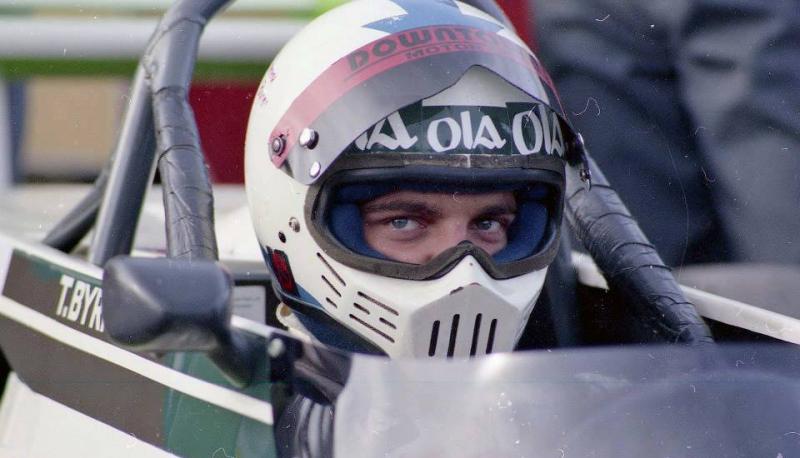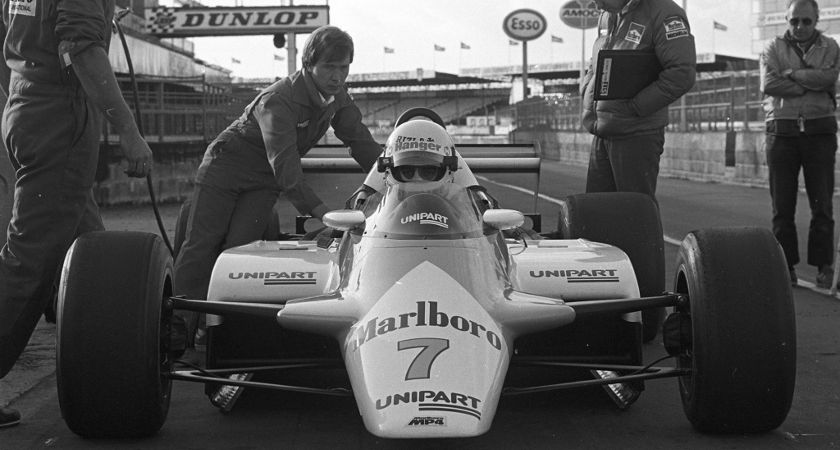Crash and Burn | reviews, news & interviews
Crash and Burn
Crash and Burn
The chaotic tale of Tommy Byrne, motorsport's nearly man

Not all racing drivers are created equal. New world champion Nico Rosberg is the son of a former F1 champion, grew up in Monaco, speaks five languages and turned down an offer to study aeronautical engineering at Imperial College, London.
On the other hand, 1980s racer Tommy Byrne was a working-class chancer from Dundalk who was permanently skint and got nicked for stealing. Yet the evidence suggests he was one of the fastest natural drivers who ever sat in a racing car, and who even gave Ayrton Senna a run for his money when both of them drove for the Van Diemen team at the start of the Eighties. But despite his gifts, he never quite attained the highest echelon of motorsport.
 Byrne's reputation as a star-crossed genius who wasted his extravagant natural talent through his reckless dalliances with drugs, booze and women was enshrined in legend in his book Crashed and Byrned: The Greatest Racing Driver You Never Saw (2008, pictured right). Now here's Seán Ó Cualáin's documentary, which puts vivid flesh on the story's bones with a plentiful stash of archive footage, a colourful bunch of talking heads, and plenty of opinionated input from Byrne himself, who's now 58, lives in Florida, and in the racing season teaches advanced driving courses at the Mid-Ohio Sports Car Course.
Byrne's reputation as a star-crossed genius who wasted his extravagant natural talent through his reckless dalliances with drugs, booze and women was enshrined in legend in his book Crashed and Byrned: The Greatest Racing Driver You Never Saw (2008, pictured right). Now here's Seán Ó Cualáin's documentary, which puts vivid flesh on the story's bones with a plentiful stash of archive footage, a colourful bunch of talking heads, and plenty of opinionated input from Byrne himself, who's now 58, lives in Florida, and in the racing season teaches advanced driving courses at the Mid-Ohio Sports Car Course.
In fact you might say it didn't turn out too badly for Byrne, who evidently enjoys a comfortable lifestyle in the States and has managed to leave his debauched excesses behind him (as fellow Irishman and F1 veteran John Watson puts it, "If there was a gold medal for shagging, he'd have won it time and time again"). He hit rock bottom when he ended up driving for some sort of gangster in Mexico, who lived a Scarface-style life of drugs and hookers, and gave Byrne an electrifying wake-up call by firing a pistol at him. He was found drowned in his swimming pool not long afterwards.
What has made Byrne's story so tantalising, apart from his garish exploits and refreshing tactlessness, is the way he hurtled meteorically from quaint local banger races in Ireland to the fringes of F1, but couldn't quite clinch the deal. In 1982, having sensationally blitzed his way to winning the Formula 3 championship (after only getting the drive because the temperamental Senna had taken a sabbatical), he drove in a couple of Grands Prix for the obscure F1 team, Theodore Racing.
 More significant was his test session with McLaren at Silverstone in October '82 (pictured above), in which Byrne set faster lap times than John Watson or Niki Lauda in a Formula One car he'd never driven before, yet bewilderingly was never offered a drive with the team. Evidently team boss Ron Dennis had taken against Byrne's ducking, diving cockiness, and several interviewees here stress that in the exclusive, corporate and intensely political world of F1, a loose cannon like Byrne was always going to struggle to fit in. As team owner turned pundit Eddie Jordan puts it, "you didn't get stability with Tommy Byrne. You got chaos."
More significant was his test session with McLaren at Silverstone in October '82 (pictured above), in which Byrne set faster lap times than John Watson or Niki Lauda in a Formula One car he'd never driven before, yet bewilderingly was never offered a drive with the team. Evidently team boss Ron Dennis had taken against Byrne's ducking, diving cockiness, and several interviewees here stress that in the exclusive, corporate and intensely political world of F1, a loose cannon like Byrne was always going to struggle to fit in. As team owner turned pundit Eddie Jordan puts it, "you didn't get stability with Tommy Byrne. You got chaos."
Byrne himself launches tirades against the pretensions and snobbishness of F1, with a bit of class warfare for good measure: "People treat you different when you're broke than when you're rich... they can smell it." It's hard to tell how serious he's being when he says "it hasn't been a terrible life. I just lost out on $100m, that's all." Perhaps he might console himself with the thought that while his rival Ayrton Senna went all the way to the top, it's only Byrne who's still here to talk about it.
The future of Arts Journalism
You can stop theartsdesk.com closing!
We urgently need financing to survive. Our fundraising drive has thus far raised £49,000 but we need to reach £100,000 or we will be forced to close. Please contribute here: https://gofund.me/c3f6033d
And if you can forward this information to anyone who might assist, we’d be grateful.

Subscribe to theartsdesk.com
Thank you for continuing to read our work on theartsdesk.com. For unlimited access to every article in its entirety, including our archive of more than 15,000 pieces, we're asking for £5 per month or £40 per year. We feel it's a very good deal, and hope you do too.
To take a subscription now simply click here.
And if you're looking for that extra gift for a friend or family member, why not treat them to a theartsdesk.com gift subscription?
more Film
 London Film Festival 2025 - crime, punishment, pop stars and shrinks
Daniel Craig investigates, Jodie Foster speaks French and Colin Farrell has a gambling habit
London Film Festival 2025 - crime, punishment, pop stars and shrinks
Daniel Craig investigates, Jodie Foster speaks French and Colin Farrell has a gambling habit
 I Swear review - taking stock of Tourette's
A sharp and moving tale of cuss-words and tics
I Swear review - taking stock of Tourette's
A sharp and moving tale of cuss-words and tics
 A House of Dynamite review - the final countdown
Kathryn Bigelow's cautionary tale sets the nuclear clock ticking again
A House of Dynamite review - the final countdown
Kathryn Bigelow's cautionary tale sets the nuclear clock ticking again
 theartsdesk Q&A: Idris Elba on playing a US President faced with a missile crisis in 'A House of Dynamite'
The star talks about Presidential decision-making when millions of lives are imperilled
theartsdesk Q&A: Idris Elba on playing a US President faced with a missile crisis in 'A House of Dynamite'
The star talks about Presidential decision-making when millions of lives are imperilled
 Urchin review - superb homeless drama
Frank Dillane gives a star-making turn in Harris Dickinson’s impressive directorial debut
Urchin review - superb homeless drama
Frank Dillane gives a star-making turn in Harris Dickinson’s impressive directorial debut
 Mr Blake at Your Service review - John Malkovich in unlikely role as an English butler
Weird comedy directed by novelist Gilles Legardinier
Mr Blake at Your Service review - John Malkovich in unlikely role as an English butler
Weird comedy directed by novelist Gilles Legardinier
 Don't Let's Go to the Dogs Tonight review - vivid adaptation of a memoir about a Rhodesian childhood
Embeth Davidtz delivers an impressive directing debut and an exceptional child star
Don't Let's Go to the Dogs Tonight review - vivid adaptation of a memoir about a Rhodesian childhood
Embeth Davidtz delivers an impressive directing debut and an exceptional child star
 One Battle After Another review - Paul Thomas Anderson satirises America's culture wars
Leonardo DiCaprio, Teyana Taylor, and Sean Penn star in a rollercoasting political thriller
One Battle After Another review - Paul Thomas Anderson satirises America's culture wars
Leonardo DiCaprio, Teyana Taylor, and Sean Penn star in a rollercoasting political thriller
 Steve review - educator in crisis
Cillian Murphy excels as a troubled headmaster working with delinquent boys
Steve review - educator in crisis
Cillian Murphy excels as a troubled headmaster working with delinquent boys
 Can I get a Witness? review - time to die before you get old
Ann Marie Fleming directs Sandra Oh in dystopian fantasy that fails to ignite
Can I get a Witness? review - time to die before you get old
Ann Marie Fleming directs Sandra Oh in dystopian fantasy that fails to ignite
 Happyend review - the kids are never alright
In this futuristic blackboard jungle everything is a bit too manicured
Happyend review - the kids are never alright
In this futuristic blackboard jungle everything is a bit too manicured

Add comment